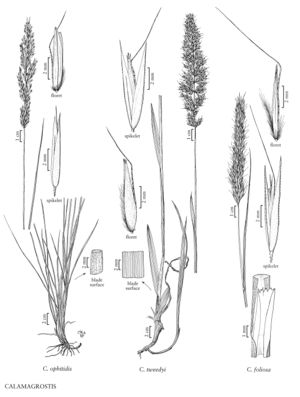Calamagrostis ophitidis
Plants usually with sterile culms; usually cespitose, often with rhizomes 2-15 cm long, 1-3 mm thick. Culms (30) 55-80(100) cm, unbranched, scabrous beneath the panicles; nodes (1)2(5). Sheaths and collars usually scabrous, rarely smooth; ligules (0.5)2-5.5(7) mm, usually truncate, entire to slightly lacerate; blades (8)10-20(27) cm long, (1.5)2-3(4) mm wide, usually involute, abaxial surfaces usually scabrous, rarely smooth, adaxial surfaces scabrous, glabrous or sparsely hairy, both surfaces with abundant white glands between the veins, visible only with magnification. Panicles (6)8-11(15) cm long, (1)1.2-1.5 cm wide, contracted, mostly erect, pale green to green; branches 2-4(4.5) cm, scabridulous, usually spikelet-bearing to the base. Spikelets (4.5)5-7(8) mm; rachilla prolongations about 1.5 mm, hairs 1-2 mm. Glumes keeled, usually scabrous over the entire surface, rarely only the keels scabrous distally, lateral veins prominent, apices acute to acuminate; callus hairs 1-1.5(2) mm, 0.2-0.4 times as long as the lemmas, sparse; lemmas 4.5-6.5 mm, 0-2 mm shorter than the glumes; awns 5-6(8) mm, attached to the lower 1/10 – 1/5 of the lemmas, exserted less than 2 mm, stout, distinguishable from the callus hairs, bent; anthers (2.5)3-3.5(4) mm. 2n = 28.
Discussion
Calamagrostis ophitidis grows in meadows, seeps, grasslands, and chaparral, as well as in coniferous forests, on serpentine outcrops and soils, at 50-1100 m. It is known only from Sonoma, Marin, Mendocino, Lake, and Napa counties in California.
Selected References
None.
